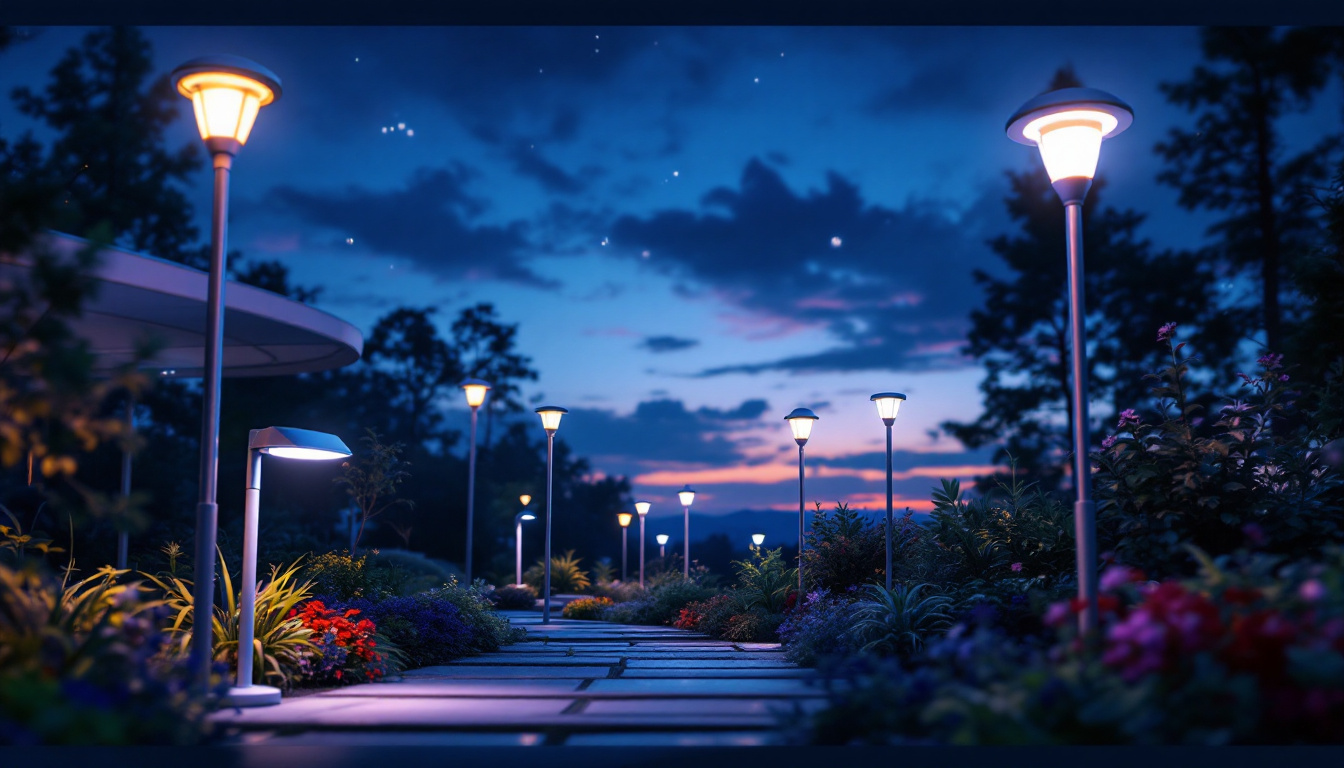
In recent years, the lighting industry has witnessed a remarkable transformation, particularly with the rise of solar-powered lights for outdoor use. These innovative lighting solutions have not only enhanced energy efficiency but have also contributed to sustainable practices. As lighting contractors, understanding the evolution of solar-powered lights is crucial for staying ahead in a competitive market.
The global push towards sustainability has significantly influenced various industries, and lighting is no exception. Traditional lighting solutions, often reliant on fossil fuels, have come under scrutiny for their environmental impact. Consequently, the demand for eco-friendly alternatives has surged, paving the way for solar-powered lighting systems.
Solar-powered lights harness the sun’s energy, converting it into electricity to power outdoor lighting fixtures. This shift not only reduces reliance on non-renewable resources but also lowers electricity bills for consumers. As a result, many homeowners and businesses are increasingly opting for solar solutions, creating new opportunities for lighting contractors.
One of the primary advantages of solar-powered lights is their cost-effectiveness. While the initial investment may be higher than traditional lighting, the long-term savings on energy costs and maintenance make them an attractive option. Additionally, solar lights are often equipped with LED technology, which further enhances their energy efficiency.
Another significant benefit is the ease of installation. Solar-powered lights do not require extensive wiring or electrical work, allowing for quicker and more straightforward installations. This feature is particularly advantageous for contractors, enabling them to complete projects efficiently and with minimal disruption to clients.
Moreover, solar-powered lighting systems contribute to a reduction in carbon footprints, making them a vital component of broader environmental strategies. By utilizing renewable energy, these systems help mitigate the effects of climate change and promote a cleaner atmosphere. Communities that adopt solar lighting often report improved public safety, as well-lit areas deter crime and enhance visibility at night. This dual benefit of sustainability and security makes solar lighting an appealing choice for municipalities and residential neighborhoods alike.
Additionally, advancements in solar technology have led to the development of more aesthetically pleasing designs, allowing homeowners to integrate these systems seamlessly into their landscapes. From decorative garden lights to robust street lamps, solar-powered options are available in various styles and functionalities, catering to diverse consumer preferences. As technology continues to evolve, we can expect even more innovative solutions that blend sustainability with design, further encouraging the adoption of solar lighting across different sectors.
The evolution of solar-powered lights is closely tied to advancements in technology. Over the years, improvements in solar panel efficiency, battery storage, and LED technology have transformed the capabilities of outdoor lighting solutions.
Modern solar panels are more efficient than ever, allowing for greater energy absorption even in low-light conditions. This advancement ensures that solar lights can operate effectively throughout the night, providing consistent illumination for outdoor spaces. Furthermore, innovations in battery technology have led to longer-lasting power storage, enabling lights to function for extended periods without requiring frequent recharging.
In addition to traditional solar-powered lights, the introduction of smart technology has revolutionized outdoor lighting. Smart solar lighting systems can be controlled remotely via mobile applications, allowing users to adjust brightness levels, set timers, and even monitor energy consumption.
This level of control not only enhances convenience but also promotes energy conservation. For contractors, integrating smart technology into solar lighting solutions can provide added value to clients, making projects more appealing and modern. Moreover, these systems often include features such as motion sensors, which automatically activate lights when movement is detected, further optimizing energy use and enhancing security in residential and commercial settings.
As the demand for sustainable solutions continues to grow, manufacturers are also exploring the integration of solar lighting with other smart home technologies. For instance, solar lights can now be synchronized with home automation systems, allowing them to respond to environmental changes, such as dimming at sunset or brightening when someone approaches. This seamless integration not only improves functionality but also contributes to a more cohesive and energy-efficient living environment, showcasing how solar lighting is not just a standalone solution but a vital component of the modern smart home ecosystem.
As the demand for solar-powered lights has grown, so too has the focus on design and aesthetics. Consumers are increasingly looking for outdoor lighting solutions that not only serve a functional purpose but also enhance the visual appeal of their spaces.
Manufacturers have responded to this trend by offering a diverse range of styles, from sleek and modern designs to more traditional and decorative options. This variety allows lighting contractors to cater to different tastes and preferences, ensuring that clients can find the perfect solution for their outdoor areas. Beyond mere functionality, these designs often incorporate innovative materials and finishes, such as weather-resistant metals and eco-friendly plastics, which not only ensure durability but also add a touch of sophistication to any outdoor setting.
Furthermore, the integration of smart technology into solar lighting design has opened up new avenues for customization. Many solar lights now come equipped with features like adjustable brightness levels, motion sensors, and even color-changing capabilities. This allows homeowners to tailor their lighting to suit different occasions, from intimate gatherings to festive celebrations, enhancing both the utility and the aesthetic of their outdoor spaces.
When incorporating solar-powered lights into landscape design, it is essential to consider placement and functionality. Properly positioned lights can highlight architectural features, illuminate pathways, and create ambiance in outdoor living spaces.
Lighting contractors should work closely with clients to determine the best locations for solar lights, taking into account factors such as sunlight exposure and desired lighting effects. By doing so, they can create cohesive and visually appealing outdoor environments that maximize the benefits of solar technology. Additionally, the strategic use of solar lights can enhance safety and security around the property, ensuring that walkways and entry points are well-lit, thus deterring potential intruders while providing peace of mind to homeowners.
Moreover, the integration of solar lights into landscaping can also promote sustainability. By utilizing solar energy, homeowners can significantly reduce their carbon footprint while enjoying the beauty of their gardens and outdoor spaces at night. This eco-friendly approach not only aligns with the growing trend towards sustainable living but also encourages a deeper connection with nature, as the soft glow of solar lights can create a magical atmosphere that highlights the natural beauty of plants and outdoor features. As such, lighting contractors play a pivotal role in educating clients about the benefits of solar technology, helping them make informed decisions that enhance both their outdoor aesthetics and environmental responsibility.
Despite the numerous advantages of solar-powered lights, there are challenges that contractors must navigate. One of the primary concerns is the variability of sunlight, which can affect the performance of solar lighting systems. In regions with limited sunlight, it may be necessary to consider alternative solutions or hybrid systems that combine solar power with traditional energy sources.
Additionally, the quality of solar products can vary significantly between manufacturers. Contractors must be diligent in selecting high-quality products that meet industry standards to ensure longevity and performance. Educating clients about the importance of investing in reliable solar lighting solutions can help mitigate potential issues down the line.
While solar-powered lights generally require less maintenance than traditional lighting systems, they are not entirely maintenance-free. Regular cleaning of solar panels is essential to ensure optimal performance, as dirt and debris can inhibit energy absorption. Contractors should advise clients on proper maintenance practices to extend the lifespan of their solar lighting systems.
Furthermore, educating clients about the expected lifespan of solar lights and the importance of battery replacement can help set realistic expectations. By providing ongoing support and guidance, contractors can foster long-term relationships with clients and encourage repeat business.
The future of solar-powered lights is promising, with continued advancements in technology and design expected to shape the industry. As consumers become more environmentally conscious, the demand for solar solutions is likely to increase, presenting new opportunities for lighting contractors.
Emerging trends, such as solar-powered streetlights and integrated solar solutions for commercial properties, are also on the horizon. Contractors who stay informed about these developments will be better positioned to meet the evolving needs of their clients.
As solar technology becomes more accessible and affordable, the market for solar-powered lights is expected to expand significantly. Contractors can capitalize on this growth by diversifying their offerings and incorporating solar solutions into their portfolios.
Additionally, partnerships with manufacturers and suppliers who specialize in solar technology can provide contractors with valuable resources and support. By staying ahead of the curve, lighting contractors can establish themselves as leaders in the industry and attract a broader clientele.
The evolution of solar-powered lights has transformed the lighting industry, offering sustainable, cost-effective, and aesthetically pleasing solutions for outdoor spaces. As the demand for eco-friendly lighting continues to rise, lighting contractors must adapt to these changes and embrace the opportunities that solar technology presents.
By understanding the benefits, challenges, and future trends of solar-powered lighting, contractors can provide valuable insights and solutions to their clients. As the industry progresses, staying informed and proactive will be key to thriving in this dynamic market.
Ready to harness the power of the sun and elevate your lighting projects? At LumenWholesale, we provide lighting contractors with the highest quality solar-powered lights that blend sustainability, performance, and design. Our spec-grade lighting products come at unbeatable wholesale prices, ensuring you get the best value for your investment. Say goodbye to middleman markups and hello to hassle-free bulk buying with free shipping. Don’t compromise on quality or cost. Visit LumenWholesale today and discover the perfect lighting solutions for a brighter, greener future.

Discover the essential checklist every lighting contractor needs to ensure successful sales and installations.

Discover innovative cost-saving strategies for lighting contractors in the electric warehouse industry.

Discover the crucial aspects of color rendering that lighting contractors frequently miss.

Discover the transformative journey of LED lights in the lighting industry.